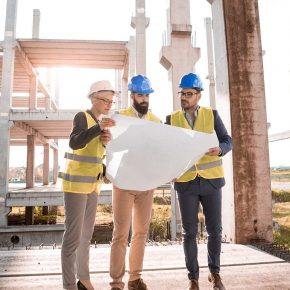
Building America: Innovation and Technology in Federal Government Construction
The federal government construction sector in the US is at a pivotal juncture, embracing a wave of innovation and technology. This transformation is not merely a shift in tools and techniques but a fundamental rethinking of how large-scale construction projects are conceptualised, executed, and managed.
Embracing Digital Transformation
The federal construction sector is seeing a significant shift toward digitalisation. This move is characterised by the adoption of various digital tools that enhance efficiency, accuracy, and collaboration. Digital solutions such as Building Information Modeling (BIM) are revolutionising the planning and execution stages of construction projects.
BIM enables a virtual representation of the physical and functional characteristics of a facility, leading to better decision-making throughout the building life cycle. Additionally, the use of drones for site surveying and 3D printing for creating construction components is further streamlining the construction process. These technologies not only accelerate project timelines but also reduce waste and improve safety on construction sites.
Sustainable Practices and Green Building
Sustainability is becoming a cornerstone of federal construction projects. The integration of green building practices and the pursuit of certifications like LEED (Leadership in Energy and Environmental Design) underscore a commitment to environmental responsibility and energy efficiency. Sustainable construction involves the use of eco-friendly materials, energy-efficient designs, and waste-reduction techniques.
These practices significantly lower the carbon footprint of construction projects and pave the way for creating buildings that are not only cost-effective in the long run but also healthier for occupants and the environment. The government’s focus on sustainability also extends to retrofitting and updating existing structures, ensuring they meet modern energy standards.
Advanced Material and Construction Techniques
The federal construction sector is increasingly utilising advanced materials and innovative construction techniques. This shift is marked by the integration of materials like self-healing concrete, which significantly extends the lifespan of structures, and the use of energy-efficient materials that contribute to the sustainability of government buildings.
Furthermore, advances in modular and prefabricated construction are gaining traction in federal projects. These methods not only expedite the construction process but also minimise on-site waste and disruptions. The adoption of these advanced materials and techniques signifies a move towards more resilient, sustainable, and cost-effective construction practices.
Integrated Project Management Tools
Integrating efficient project management tools is key in modernising federal construction projects. The adoption of government construction management software is a prime example of this integration. This software provides a comprehensive platform for managing all aspects of construction projects, from bid management to asset handover.
It facilitates better coordination among various stakeholders, ensures adherence to schedules and budgets, and enhances overall project transparency. The use of such integrated tools allows for a more streamlined, efficient, and accountable construction process, which is essential in handling the complexities and scale of federal construction projects.
Cybersecurity in Construction
Incorporating robust cybersecurity measures has become a critical aspect of federal construction in the digital age. The digitalisation of construction processes has made cybersecurity an indispensable part of project management. Protecting sensitive information related to construction designs, infrastructure plans, and other data is paramount.

The federal government is investing in advanced cybersecurity protocols and systems to safeguard this information from potential threats and breaches. This focus on cybersecurity ensures the integrity and confidentiality of critical infrastructure projects are maintained, thereby securing the nation’s assets.
Workforce Development and Training
The evolving technological landscape of federal construction necessitates a workforce that is skilled in modern methodologies and technologies. This has led to a greater emphasis on workforce development and specialised training programs. These programs are designed to equip workers with the necessary skills in areas such as advanced construction techniques, digital tools, and sustainable practices.
Public-Private Partnerships
Public-private partnerships (PPPs) have emerged as a vital component in the execution of federal construction projects. These partnerships leverage the strengths of both sectors, combining the innovative capabilities and efficiencies of private enterprises with the scale and funding of federal projects.
PPPs allow the government to access private capital and expertise, leading to cost-effective and timely project completion. These collaborations often result in innovative solutions that might not be feasible through traditional procurement methods. The increasing adoption of PPPs signifies a collaborative approach to tackling the complex challenges of modern construction.
Compliance and Regulatory Frameworks
Navigating the evolving landscape of compliance and regulatory frameworks is a critical aspect of federal construction projects. The government continuously updates and enforces construction standards and regulations to align with the latest technologies and sustainable practices. Compliance with these frameworks is essential for the legality of the projects and ensuring public safety and trust. The federal government’s commitment to upholding these standards reflects its dedication to maintaining the highest levels of quality, safety, and integrity in its construction projects.
Conclusion
The integration of innovation and technology in federal government construction projects is a testament to America’s commitment to building a future that is efficient, sustainable, and secure. As the sector continues to evolve, it is imperative for government decision-makers to stay abreast of these advancements and incorporate them into their practices.
This journey towards modernization is not just about constructing buildings; it’s about laying the foundation for a resilient and prosperous America. Through embracing these innovations, the federal government is setting a benchmark for construction excellence, driving the nation towards a brighter and more sustainable future.
Latest news

26th July 2024
Enfield Speciality Doors completes world-class project for Atlas Copco HQ
A rundown office and warehouse building completely transformed into a modern headquarters for Atlas Copco has been fitted with more than 120 internal fire doors from Enfield Speciality Doors.
Posted in Access Control & Door Entry Systems, Articles, Building Industry News, Building Products & Structures, Building Systems, Case Studies, Doors, Interior Design & Construction, Interiors, Posts, Restoration & Refurbishment, Retrofit & Renovation, Security and Fire Protection, Sustainability & Energy Efficiency, Timber Buildings and Timber Products, Wooden products
26th July 2024
Abloy UK launches new white paper
Abloy UK, a leading provider of security and access control solutions, has launched a new white paper.
Posted in Access Control & Door Entry Systems, Architectural Ironmongery, Articles, Building Industry News, Building Products & Structures, Building Services, Doors, Facility Management & Building Services, Health & Safety, Information Technology, Innovations & New Products, Publications, Research & Materials Testing, Security and Fire Protection
26th July 2024
MCRMA Member Profile: David Roy, Director of Roofconsult
David Roy of MCRMA member company Roofconsult has more than 50 years’ experience to draw upon working in the building envelope sector and a unique perspective on how it has changed in that time.
Posted in Articles, BIM, Infrastructure & CAD Software, Building Associations & Institutes, Building Industry News, Building Products & Structures, Building Services, Building Systems, Cladding, Information Technology, Restoration & Refurbishment, Retrofit & Renovation, Roofs, Walls
26th July 2024
Strand: Enhancing Door Functionality and Safety
Craig Fox, Sales Director for Strand Hardware, outlines how door industry professionals might apply door limiting stays…
Posted in Architectural Ironmongery, Articles, Building Industry News, Building Products & Structures, Building Services, Doors, Facility Management & Building Services, Health & Safety, Restoration & Refurbishment, Retrofit & Renovation
 Sign up:
Sign up: